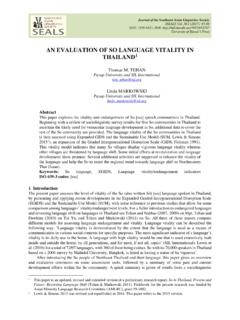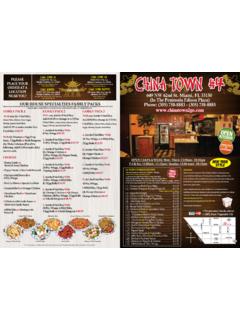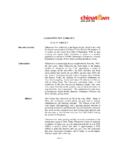Transcription of My Experiences in the Honolulu Chinatown Red-Light District
1 TED CHERNINMy Experiences in the HonoluluChinatown Red-Light DistrictI CAME TO Honolulu in December 1938 along with about a dozenother civilians aboard the troop ship USS Henderson, taking a full ninedays to make the crossing from San Francisco. That came aboutbecause in January one of the engineering professors at the Univer-sity of California, where I was a senior in electrical engineering, toldthe class that it looked like a bad year for engineers and advised us tolook into a government civil service announcement posted in the hall-way for engineering positions of all applied but heard nothing more until October, months after Ihad graduated.
2 When a telegram came from the Navy Departmentasking me if I would accept a job as junior radio engineer at the PearlHarbor Naval Shipyard at $2,000 per year, plus a 25 percent cost-of-living allowance. That was more than twice the going rate for engi-neers. I had to look in an atlas to find where Pearl Harbor was andlearned it was in the Hawaiian Islands about ten miles from quickly replied YES. A stiff two-day examination was required inthose days to qualify for civil service, but since I had graduated in June(my major was in communications with a minor in electric power), Ipassed it ship left San Francisco on Thanksgiving Day, and I becameseasick but recovered in time to enjoy several days of watching por-poises and flying fish playing as they accompanied the ship.
3 The shipTed Chernin lives in Pearl City and is a frequent contributor to Honolulu newspapers oncurrent and historical Hawaiian Journal of History, vol. 34 (2000)203204 THE HAWAIIAN JOURNAL OF HISTORY docked in Honolulu on Friday, December 2, 1938, and after the chillyweather I was accustomed to, the relatively high temperature andhumidity as I walked down the gangplank made me feel as though Ihad entered a Turkish bath though it was after 7 It took me morethan a year to become acclimated. The several civil service recruitsfor Pearl Harbor employment (the single men) were taken to theArmy-Navy YMCA at the corner of Hotel and Richards streets.
4 Myemployment was in the Design Division, known at that time as theIndustrial Drafting Room, along with three other recruits: Conrad , who much later headed the IEEE Standards Committee,Joseph Baresh, and William F. stayed at the Army-Navy Y a week, then moved to a cottage inWaikikl, "batching" it. I found myself spending all my time in thedowntown area, especially the colorful Chinatown and adjacentareas, so I decided to move back. A co-worker, Daniel Y. S. Pang, anold-timer there, had taken me under his wing when I arrived, andwhen he learned of this, he got me a room at the Nu'uanu YMCA,only a couple of blocks from the downtown and Chinatown , I had never visited San Francisco's Chinatown while I livedthere.
5 I am forever grateful to Dan Pang for showing me the ropesand making me feel at home here, on and off the job also to BungTong Chang, Lee Hau Chun, Charles Jo Wong, Chew Wong, DavidMun Chew "China" Wong, Leon Young, and many other "locals."I would walk a few blocks from the Nu'uanu Y to the downtown andChinatown areas, and I would see local women who had come in fromthe countryside, the Japanese women dressed in their colorful andbeautiful kimono and obi, wearing ornate zori (Japanese slippers);Hawaiian women with their holoku gowns and wearing lei aroundtheir necks and haku lei on their heads, some of the younger oneswith a flower on one ear or the other to indicate whether they wereavailable or spoken for.
6 Korean women in their voluminous costumesreminiscent of nuns' habits, only white in color; and Chinese womenin colorfully embroidered silk blouses and black silk slacks, somehobbling because their feet had been bound when they were infants,in accordance with ancient Chinese all had three-year contracts expiring on December 4, to the contract terms, we were eligible for the first availabletransportation, nicknamed FAT, be it government or commercial, aMY Experiences IN THE Red-Light District 205common arrangement.
7 Baresch, Keller, and I left on the Matson linerLurline on Friday, December 5, 1941, thereby escaping the attack thefollowing Sunday, December 7. Muller, who worked in the Radio Sec-tion, stayed behind. I wanted to, also, but our boss, W. W. Mcllhenny,would allow only one of us to stay, and I lost the toss of the coin. Whenpeople not aware of the three-year contract expressed surprise that Ishould leave after enjoying the life in Honolulu for three years, Iwould kid them by saying, "Oh, I had advance notice." Some of themwould look at me Keller and I got into some misadventures on board ship andwere taken for spies but were cleared by the FBI upon arrival in SanFrancisco December 10.
8 Just a few months later, in April 1942, Kellerand I returned to our jobs in the shipyard. I had begun to feel home-sick for the Islands and was happy to be of my fellow students at Cal had shipped out during summervacation to earn tuition and living expenses doing menial jobs on Mat-son ships that sailed between Hawai'i and the mainland. I had heardfrom them that Honolulu had an open Red-Light District in its China-town. When I asked about this upon my arrival at the Army-Navy Y, Iwas quickly shown these "houses of ill repute." A localism for them was"boogie houses": the women were "heads.
9 " A euphemism used whensuggesting a visit to one was "let's go climb the stairs," because almostall were in upstairs locations. I knew of ten that were crammed intothe very few streets and square blocks of Chinatown , bounded byBeretania, River, Kukui, and Nu'uanu streets, and five more on theoutskirts (Fig. 1).1It was interesting that, although illegal, their existence wasaccepted as necessary. Originally located in Iwilei, they were moved tothe Chinatown To make them acceptable, they were very strictlycontrolled, the Honolulu Police Department having the chore ofkeeping them in line.
10 The "girls" were medically examined were required to live in the houses. They were not allowed todo any streetwalking, and when they went out, they were not allowedto be accompanied by anyone. Curfew was 10:30 They could visitonly certain beach areas during weekdays. No drugs or alcohol wereallowed. The madams were required to see that the girls behaved andcaused no trouble. The houses were required to be kept in a clean,neat, and sanitary condition. To this day, I can recall the characteris-FIG I. Map of Chinatown locations of houses of prostitution during World War II, drawn by the author from memoryabout 1966.












